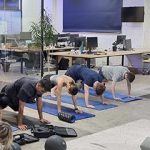How Can Tight Hip Muscles Impact you?
Thank you for taking the time to read our blog on hip stretches. As always we hope you learn something and find some value in performing these movements! At this point we would like to remind you that a neutral pelvis is the ideal default position for the human body. However, throughout my time as a personal trainer, I can tell you it is rare for people to have perfect neutral alignment, often hips are tilted slightly forward and or to one side. Performing these stretches can help to improve the position of your pelvis and this can lead to more efficient and pain free movement.
We are now going to go a little deeper, with an example of how a tight muscle can impact your alignment. The ‘psoas major muscle combined with the illicaus’ also known as the ‘hip flexors’ are commonly identified as muscles that can impact our movement and can lead to issues such as lower back pain. Lets have a brief look at why!
Psoas Major
Iliacus
Firstly, consider where they attach on the body. The psoas major attaches directly to the spine and inserts on the upper femur (the large bone of the upper leg). The illiacus attaches at the pelvis and inserts into the same point as the psoas. These muscles are powerful and used excessively in day to day life (particularly the psoas major) as they help to stabilise our spine when we are sitting. For this reason they are constantly engaged and contracted. Over long periods of time, they can become ‘fixed’ to some extent in this contracted position, even when we are standing, walking and running. Therefore, we are performing our daily movements from a less than ideal position and this significantly impacts the efficiency of our movement and often leads to pain (again lower back pain is one of the major issues here).
Stretching can help us to elongate these muscles and improve our movement. As the back muscles and anterior torso muscels i.e. psoas major, work together. It is suggested that you include both hip stretches and back stretches in your program. Finally if you feel any pain or something does not feel right while performing these movements, you should stop and seek advice from a health professional!
Kneeling Hip Flexor Stretch
- Kneel on your right knee, bring left foot out in front of you and place flat on the ground.
- Keep a neutral spine move hips forward and angle them angle them up (should feel the stretch on the right side)
- Bring your right arm above your head and lean to one side for an extra stretch
- Hold for 30 seconds to 2 minutes and repeat on the opposing side.
Kneeling Hip Flexor Stretch (Advanced)
- Kneel on your right knee, bring left foot out in front of you and place flat on the ground.
- Grab your foot right foot with your right hand and bring your heel up towards your back
- NB: This is an advanced stretch (progression) however, it will provide a greater stretch to both the rectus femoris (a central quadricep muscle) and your illiospsoas.
Lying Quad Stretch
- From a lying straight position, slowly bring your right heel up towards your back
- Grab your foot with your right hand and pull it down in order to attain a greater stretch through your quads
- Hold for 30 seconds to 2 minutes and repeat on the other side.
Hamstring + Calve Stretch
- Starting from a standing position, with feet shoulder width apart, lean forward and place hands on the ground.
- Aim to keep you legs as straight as possible, however it is likely you will need to have a knee bend when first trying out this stretch.
- Aim to keep your heels on the ground.
- You should feel this down the entire back of the legs, hamstrings + calves
- Hold for 30 seconds to 2 minutes.
Glute Stretch (Pigeon Pose)
- From all fours, bring your right knee towards your right wrist.
- Slowly bring your right ankle over and position it roughly in front of your left hip
- Slide your left leg back and point your toes back with your heel facing up
- Inhale and as you exhale, walk your hands forward and lower your upper body towards the floor. From here you can rest your forearms and forehead on the mat.
- Aim to hold for 30-60 seconds each side
- NB- If you feel any pain in your knees whilst doing this, revert to a kneeling hip flexor stretch.
Bonus Stretches: Banded Distractions
When it comes to flexibility, there is more to it than simply elongating particular muscles. Theoretically if a muscle is in a less than optimum and overly tight position, stretching should help to improve the range of motion that muscle can encounter. However, stretching is one piece of the puzzle. According to author Michael Alter, through his book “Science of Flexibility’ resistance to movement has multiple contributing factors, with the major one being joint capsule restriction. To put this into context, consider the hip joint. If the head of the femur, is not sitting in the acetabulum (hip capsule) in a central position, it will not be able to move with maximal efficiency. Muscle imbalances, can pull the femur away from ideal alignment and this can of course affect our day to day movement (most of the time we won’t notice it). Banded distractions is a move we first discovered through “Becoming a Supple Leopard” written by Dr Kelly Starlett. Performing banded distractions, can help to move the joints back into alignment and therefore improve overall movement of the joint.
Hip Flexor Stretch + Lateral Banded Distraction
- Attach a resistance band to a fixed object. From here position the other end of the band around your mid-thigh (right leg)
- Move into a lunge position with your right leg forward of the body and the left leg stretching back behind you.
- Ensure you are feeling a pull in your hip flexors whilst also resisting against the lateral pull of the band.
- As the band pulls against the thigh, look to switch between resisting against the band, slightly relaxing against the pull and repeat. This is a dynamic movement, your thigh should only be moving left to right very slightly.
Hip Flexor Stretch + Banded Distraction
- Attach a resistance band to a fixed object. From here position the other end of the band around your mid-thigh (left leg)
- Assume the kneeling hip flexor stretch position (ensure you are keeping a neutral spine, shoulders retracted, chest out)
- Squeeze the left glute and push hips out against the band, allow glutes to relax and repeat
- Perform this for 60 seconds on each side
Thanks for taking the time to read our blog on stretching to free up your hips. We hope this helps you improve your movement. Finally a reminder that the training and instructional content contained on this website should be taken as information and not medical advice. If something doesn’t feel right whilst performing these exercises, stop and seek advice from a health professional.















